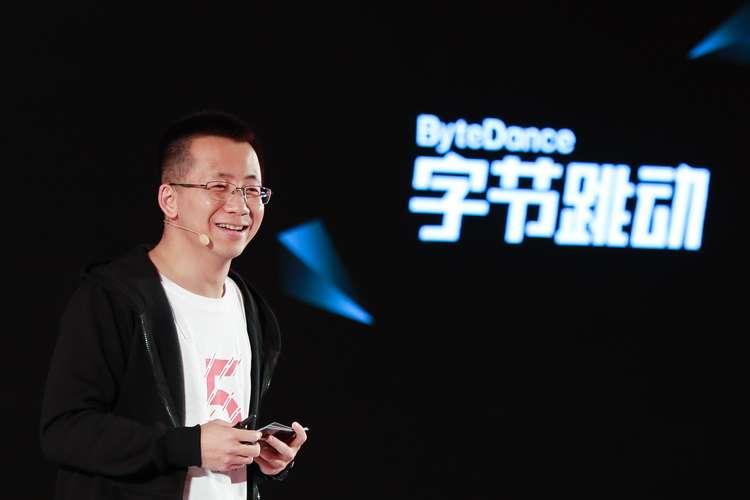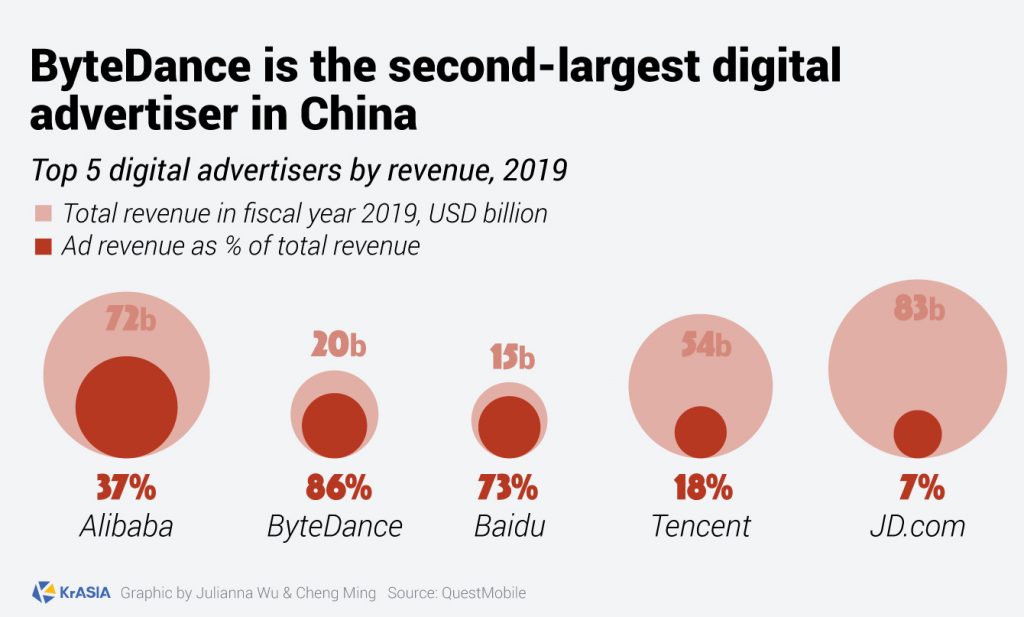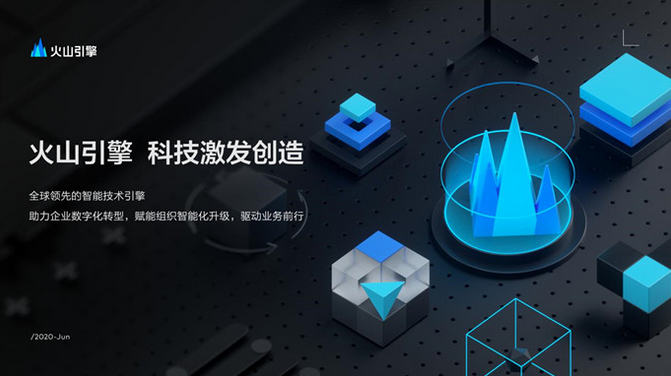What comes to mind when one thinks of ByteDance tends to be its incredibly popular social media services, such as TikTok or Douyin. ByteDance, through these platforms, has created many a new social media star, like Zhang Aiqin of Xue Hua Piao Piao and beauty product sensation Li Jiaqi.
What may be less obvious is ByteDance’s slow creep into the B2B scene. Lark, or its Chinese equivalent Feishu, is a workplace collaboration tool that ByteDance pushed in the aftermath of the COVID-19 crisis. Slowly gaining prominence in the remote working scene, it combines elements of Slack, Google Docs, Dropbox, and Skype.

More mysterious, however, is the newest member of ByteDance’s B2B cast—Huoshan Yinqing (“Volcano Engine”)—which was just launched in the later part of June 2020.
In this piece, we look at what motivations may lie behind ByteDance’s B2B investments, and how Volcano Engine fits into ByteDance’s enterprise strategy.
ByteDance begins a new growth story
For some backstory, let’s take a quick look at why ByteDance might want to enter the enterprise industry. A simple answer might just be because it can. ByteDance fights with Google (NASDAQ: GOOG) and Facebook (NASDAQ: FB) for top talent and holds its own. For instance, ByteDance beat all US tech giants to top search volume growth on Blind, a popular professional social network among tech workers, in 2020.
In addition, it is remarkable that as an internet company, ByteDance has allegedly managed to reach profitability prior to listing. In 2019, ByteDance generated more than USD 17 billion in revenue and more than USD 3 billion in net profit.
If this is true, it is sitting on a formidable pile of funding and there is no imminent need to rush for a listing to plug financial gaps in its expansion.

Despite this, however, ByteDance’s credentials as the “world’s most valuable startup” will be tested if and when (probably just when) it decides to list.
With ByteDance generating outsized expectations of its performance, it needs to have a solid growth story to maintain valuations surpassing the likes of Alibaba (NYSE: BABA) and Tencent (0700.HK), and invariably dethrone Baidu in the BAT triumvirate.
With its financials and growth story laid bare for the world’s hungry investors to pick apart, however, slowing growth in ByteDance’s consumer-facing products may present a problem. According to Sensor Tower, the number of first-time downloads for ByteDance’s products in the third quarter of 2019 declined 4% from a year ago.
This is partially due to the incredible speed at which ByteDance rose, making it hard for such breakneck growth to be sustainable. Douyin’s daily active users, for instance, increased from 30 million in January 2018 to 400 million in January 2020.
ByteDance also experienced its fastest growth in the first half of 2018, with a 400% month-on-month increase and a peak growth rate of 733% year-on-year in January 2019.
However, Douyin’s phenomenal growth rate seems to have hit a bottleneck, with month-on-month growth rates of daily active users (DAU) dropping to 67% in January 2019, and decreasing to 28% in June 2019. DAU growth was further reduced to 25% in January 2020.
This does not mean by any measure that ByteDance has stopped growing, or that it is on the decline. Its year-on-year user growth rates are still positive. Compared to more mature businesses such as Facebook and Weibo, it has not quite reached a plateau in revenue growth yet.
However, in the face of a perfect storm of slowing customer growth, potential slowdown in ad revenues in the wake of a recession, maturing consumer-facing businesses, and global tech tensions, ByteDance seems to be pre-emptively acting to avoid hitting a growth ceiling.

In addition, ByteDance’s phenomenal success in terms of advertising revenues may turn around to bite it. ByteDance was the second-largest digital advertiser in China in 2019, generating USD 17.2 billion in revenues and only coming second to Alibaba.
However, the company’s reliance on advertising as a revenue driver, at 86% of total revenue, is far outsized compared to its aspirational peers Alibaba (37%) and Tencent (18%). This itself presents a danger to revenue sustainability and business risk-hedging.
This risk is complicated by the fact that the advertising industry may be more fairweather than most. The beating that Facebook’s share price took, with USD 60 billion erased in the span of two days in the wake of advertiser boycotts, is a cautionary tale about relying on advertising as a stable revenue driver in a world where attention spans and public sentiment can be fickle.

On the pull side, enterprise services can become a veritable source of stable and growing revenues once customers are sufficiently tied to a product, although this can take many years to achieve. With a reliable product, IT managers have little incentive to gamble on something new.
For instance, Amazon (NASDAQ: AMZN) revolutionized the cloud computing industry by introducing Amazon Web Services, now famously known as its cash cow. It buoys the whole company and constitutes at least two-thirds of Amazon’s overall operating profit—more so than its more famous e-commerce service.
Opportunities in this area are ripe, especially given the relative immaturity of the Chinese enterprise services market. In 2017, the Chinese software and information technology services industry was valued at RMB 5.5 trillion (USD 825 billion). However, enterprise services only had a market size of RMB 16.9 billion (USD 2.5 billion).
It is also worth noting that COVID-19 has truly given workplace collaboration tools a boost like never before.
Overnight, it added USD 2 billion to Zoom founder Eric Yuan’s fortunes and led companies scrambling on a race to imitate his success. Facebook and Tencent, for instance, introduced spins offs of Zoom conference rooms seemingly overnight.
A spin on social media applications
While Feishu and Lark were quite clearly positioned as workplace collaboration tools, Volcano Engine seems to hint at broader ambitions: a catch-all for ByteDance’s enterprise software factory.
Positioned as an umbrella “intelligent technology platform”, Volcano Engine provides a laundry list of enabling tools that companies can pick and choose from.
“ByteDance is a global Internet company that has grown rapidly in the past eight years. During this process, our accumulated technical capabilities, growth concepts, and operating tools have played a vital role,” explained Xiao Mo, Head of Volcano Engine.
“Volcano Engine was launched in the hope of enabling our tools and capabilities to be commercialized and transformed into services, jumping from 0 to 1, and from 1 to N, with the aim of helping to serve more industries and partners. This will help everyone’s business develop rapidly and enhance competitiveness.”

Rather than being a suite of traditional enterprise-enabling technologies, however, Volcano Engine focuses more on the capabilities that could be generated by ByteDance’s unique standing as a technology company.
For instance, Volcano Engine does not present the core Customer Relationship Management (CRM), Human Resource Management (HRM), and Enterprise Resource Planning (ERP) services that are traditionally associated with enterprise enablers.
At the moment, rather, it presents twelve technical products across four key areas, namely: smart applications, visual intelligence systems, data intelligence systems, and multimedia technology.
To put it more simply, Volcano Engine seems to be staying out of more traditional “line of business” applications and has moved towards advanced technologies and capabilities for more complex intelligence-driven challenges.
“At this stage, we want to provide two kinds of services to Chinese corporate customers,” suggested Xiao Mo. “Data intelligence, and experience intelligence.”

To do so, it seems to be driving product development through access points that have synergies with its consumer-facing social live streaming and news recommendation products.
Its current products, for instance, include video on demand, video live broadcast, enterprise live broadcast, real-time communication, ImageX image service, application factory, message service, access control, and video conference services.
In its initial phase, this strategy is also a safe mid-way bet on transformation, owing to ByteDance’s relative unfamiliarity with the enterprise market. Spinning off variants of its pre-existing tools for enterprise use could help hedge research expenditure on unproven markets.
For example, Volcano Engine includes intelligent recommendation services that provide customized recommendation algorithms for enterprise customers. This bears obvious similarities to ByteDance’s flagship products: Jinri Toutiao and Douyin, which distinguish themselves from peer social media products due to their powerful search and recommendation algorithms.
Such recommendation algorithms, when customized for business applications, can be used for product discovery, internal company database optimization, customer segmentation, and product testing, to name a few.
For instance, the company allegedly cooperated with an unnamed Chinese mobile phone manufacturer, resulting in the increased efficacy of its product (A/A) testing mechanisms and leading to over 30% in revenue growth for customers.

Similar to TikTok and Douyin’s plethora of visual interaction and movement-tracked filters, Volcano Engine also provides visual intelligence systems that can detect and follow hand positions and limb movements for enterprise use.
For instance, Hisense uses Volcano Engine’s products to provide gesture control in smart television applications and create interactive special effects in its entertainment systems.
Haier (1169.HK), a leading home appliance brand, also uses such gesture-sensitive technologies to power its smart home technologies, starting with its line of Leader refrigerators.

The use cases of Volcano Engine’s products also include more aesthetic tweaks familiar to users of social media apps, such as “beautification filters.”
While these may seem frivolous, one should not underestimate the workplace camaraderie that could be generated from bosses being empowered to turn themselves into potatoes during video conferences or widespread cries for “decency filters” from many a disheveled remote-worker.
Potential experimentation with customer bands
COVID-19 was a transformative event that made digitalization not just an esoteric concept for companies, but a necessity.
Jumping on this bandwagon, ByteDance has also sought to position Volcano Engine as an engine for digital transformation, with the byline of its website (in Chinese) referring to it as a “leading intelligent technology platform that assists enterprises in digital transformation, empowers organizations to upgrade intelligently, and drives business forward.”
The tools currently offered on Volcano Engine are presented in a modular way, and span the entire data journey, from data discovery, integration, analysis, optimization, and verification, providing easy ample access points to the data economy.
The simple modularity of such a presentation leaves one to wonder who Volcano Engine’s target customers are. Could this be an attempt by ByteDance to speed up the construction of its business ecology for small and medium enterprises (SMEs) new to the digitization game?
At the moment, beachhead customer accounts for Volcano Engine revolve around big-name brands such as Haier, Hisense, and Samsung, for example – which makes sense for an initial go-to-market strategy that needs highly visible test cases for credibility.
This does not detract from the possibility that Volcano Engine’s core play may be in end-to-end digital transformation capabilities for less well-equipped corporate customers.
This is a sizeable market to tap into: according to Statista, SMEs represented more than 90 percent of the enterprises and accounted for 80% of jobs in China as of 2019.

Just for comparison, however, Feishu recently hinted at a shift in strategy towards attracting bigger accounts in the tech, media, and communications sector around the same time Volcano Engine was launched in June 2020.
Any divergence in the target customer bases of these two enterprise products would be intriguing and would call into question whether ByteDance has the resources to spread itself thinly across the market.
Initially, Feishu seemed determined to focus on SMEs and startups – for instance, it announced that it would be implementing a three-year preferential policy for SMEs in an attempt to attract companies.
As a latecomer in an enterprise market filled with big players such as Alibaba and Tencent, attempting to win over smaller companies at the beginning of their growth story, and then tying them into ByteDance’s ecology from an early stage could also be a key differentiation play.
This is presumably owing to the difficulty of sustaining platforms on a trickle of customer accounts, compared to Alibaba’s DingTalk and Tencent’s WeChat enterprise systems, which already take up a substantial portion of the market.
Coming for small businesses early might make them grow up with Feishu, leading to a prohibitive cost of change. Switching to an alternative application would mean incurring a great deal of organizational pain and expense that SMEs might not want to incur, just for marginal differences in product popularity or quality (if any).

However, dealing with SMEs might mean relatively incremental user and revenue gain. In contrast, selling to major customers may prove to be more lucrative and efficient. In addition to providing revenue from secondary product development, larger customers can contribute to a more rapid accumulation of users.
For instance, in February 2020, Feishu signed on China Resources Group, which led to the registration of China Resources’ 400,000 employees in a remarkably short period of time.
The shift in Feishu’s strategy echoes Google Suite’s shift to gunning for bigger enterprise customers, albeit at a far more rapid pace. When Google’s service debuted in 2006, it originally gunned for schools and small companies, but by 2016, Google began to seek bigger, more profitable clients, bringing in new leaders and rebranding its business apps as G Suite.
However, the shift to dealing with larger enterprise accounts may prove to be even more challenging to ByteDance, which is already struggling to transition towards B2B capabilities from its native consumer-oriented roots. The difficulty of dealing with larger corporate clients and the associated cost involved is reflected in Google’s own struggles during its transition.
“It’s no longer one employee at a small startup administering us,” said Prabhakar Raghavan, a vice president at G Suite, back in 2018. “These are demanding chief information officers. They are not going to come on a website and click a ‘buy’ button.”
Hinting at ByteDance’s flirtations with the cloud industry
At first blush, it seems like Volcano Engine remains above the fray when it comes to cloud computing capabilities, with its comprehensive menu of software capabilities lacking such explicit mention.
In 2019, however, ByteDance submitted a trademark application for the name “Bytecloud”, allegedly submitted a review for the domain name “bytecloud.com”, and registered a WeChat account under the name “Bytecloud”. This does provide fertile grounds for speculation.
So far, ByteDance has denied that it has plans to enter the cloud industry. At Volcano Engine’s launch on June 22, 2020, a company spokesperson again insisted that “ByteDance had no current plans to enter the cloud industry.”
The statement is reminiscent of when ByteDance launched its early-stage search engine business in August 2019, with an emphasis on keeping a low profile.
When the company introduced a mobile search portal called Toutiao Search, a spokesperson told KrASIA that the company had “no plans to release a standalone search engine app.” However, half a year later, the eponymous standalone search engine was launched.

If it did launch full-scale standalone cloud enterprise services, however, it would not be surprising, as the tandem of enterprise and cloud services can produce significant synergies.
For instance, Volcano Engine already offers services that let companies livestream, hold video conferences, manage and distribute photos and videos on a cloud-based platform.
At the moment, ByteDance seems to be relying on a mix of neutral third-party cloud providers and private cloud. However, cloud computing can be an attractive industry to enter into – if the company is prepared to fork out high capital expenditures.
According to the Information Communication Institute’s White Paper on Cloud Computing Development in 2019, the size of China’s public cloud market in 2018 was RMB 43.74 billion. China’s cloud market is expected to reach RMB 173.13 billion by 2022, with a compound growth rate of 41.1%.
If Volcano Engine’s enterprise software is paving the way for “Bytecloud” in the future, it would an amusing reversal of Google’s attempt to reshape its cloud division into an enterprise software hothouse in 2015.
Upon its acquisition of VMware in 2015, Google had attempted, somewhat unsuccessfully, to move from being a pure “cloud” enterprise to a wholesome service provider for its enterprise clients under the leadership of VMware’s co-founder, Diane Greene.

In addition, Lark/Feishu relies heavily on its cloud storage services as a selling point for customers, cheekily framing itself as one of the “best alternatives to Google Drive in 2020“. The free version of Lark/Feishu alone includes about 10 GB of cloud storage for each customer.
Allegedly, this information is backed up through Amazon Web Services, although it is unclear the extent to which ByteDance depends on it. With ambitions to scale Lark/Feishu to greater heights, it might be sensible for ByteDance to take cloud in-house instead.

Any further cloud aspirations, however, will remain in a state of flux at the moment. As of June 29, it was reported that Xu Zhe, the Product Director of ByteDance in charge of Feishu, left the company to form his own business in the e-commerce SaaS field.
“Xu Zhe believes that ByteDance cannot only do IM (Instant Messaging), which lacks any competitive advantage. Instead, we must develop cloud capabilities, and use this to develop collaborative capabilities and synergies in the market,” said an anonymous Feishu employee familiar with Xu Zhe to 36Kr.
Regardless of the veracity of ByteDance’s cloud ambitions, the mysterious ambit of Volcano Engine will be one to watch in the next few months.
